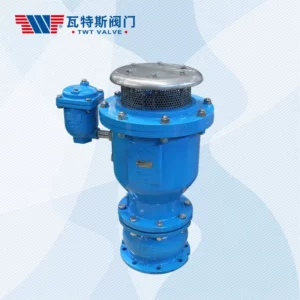The Role of double orifices air vavle in Function Optimization
Double orifice air valve play a significant role in function optimization within fluid systems. These valves are specifically designed to release or admit air during system operation, helping to maintain system efficiency and prevent issues such as air accumulation, water hammer, and cavitation. Here are the key roles of double orifice air valves in function optimization:
Air Release and Admittance:
Double orifice air valves are designed to release air from the system when it accumulates in pipelines, especially at high points or areas where air pockets tend to form. The release of air helps prevent air binding, which can hinder fluid flow and reduce system efficiency. On the other hand, when the system is drained or under vacuum conditions, the double orifice air valve can admit air to prevent vacuum collapse, ensuring optimal system performance.
Preventing Water Hammer:
Water hammer occurs when there is a sudden change in fluid flow, leading to pressure surges that can cause damage to the system. Double orifice air valves play a crucial role in preventing water hammer by allowing the controlled release or admittance of air during fluid flow changes. By releasing or admitting air, these valves help absorb the energy generated during flow fluctuations, reducing the impact on the system and minimizing the risk of water hammer.
Cavitation Prevention:
Cavitation is a phenomenon that occurs when the pressure of a fluid drops below its vapor pressure, leading to the formation and subsequent collapse of vapor bubbles. This collapse can cause damage to equipment and reduce system performance. Double orifice air valves help optimize system function by releasing air and maintaining pressure equilibrium, thus preventing cavitation and its detrimental effects.
Pressure Management:
Double orifice air valves assist in maintaining proper pressure levels within fluid systems. By releasing or admitting air, these valves help regulate pressure variations caused by changes in fluid flow, temperature, or system operation. Proper pressure management is crucial for system efficiency, as excessively high or low pressures can lead to inefficiencies, leaks, or equipment damage.
System Protection:
Double orifice air valves play a vital role in protecting the overall system from potential damage. By releasing air, these valves help prevent the accumulation of air pockets that can hinder fluid flow, reduce pump efficiency, and cause blockages. By admitting air, they prevent the formation of vacuum conditions that can lead to pipe collapse or damage. The protection provided by double orifice air valves ensures the longevity and reliable operation of the fluid system.
Efficient Operation:
By maintaining system efficiency and preventing issues such as air accumulation, water hammer, and cavitation, double orifice air valves optimize the overall operation of fluid systems. These valves ensure the smooth flow of fluids, minimize energy losses, and reduce the need for frequent maintenance or repairs. The efficient operation achieved through the use of double orifice air valves translates into improved system performance, reduced downtime, and cost savings.
System Monitoring and Control:
Implementing a comprehensive system monitoring and control system that includes double orifice air valves enhances function optimization. By utilizing technologies such as pressure sensors, flow meters, and control systems, operators can monitor system conditions in real-time. This allows for proactive adjustments and preventive actions, such as adjusting valve settings or activating alarms, to optimize valve performance and system efficiency based on changing requirements.
In summary, double orifice air valves play a crucial role in function optimization within fluid systems. They facilitate air release and admittance, prevent water hammer and cavitation, manage pressure levels, protect the system, enable efficient operation, and can be integrated into system monitoring and control. By utilizing these valves effectively, fluid systems can achieve optimal performance, increased efficiency, and reduced maintenance requirements.



Comments
Post a Comment